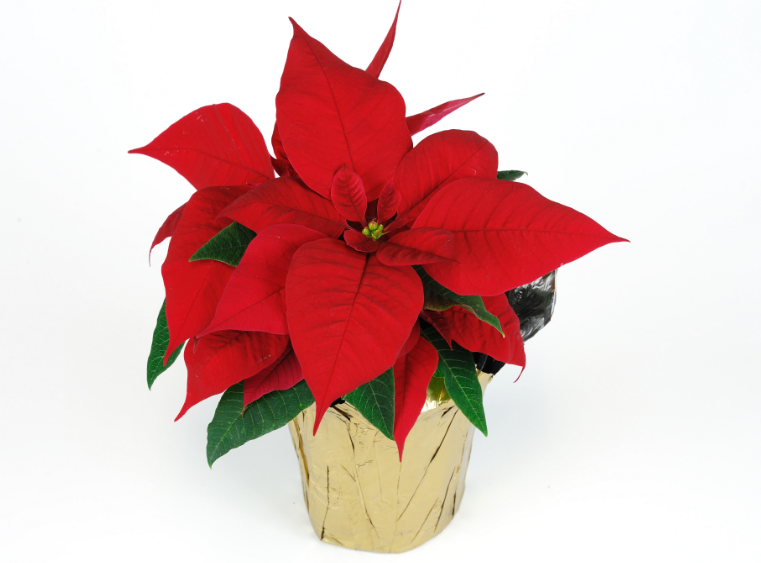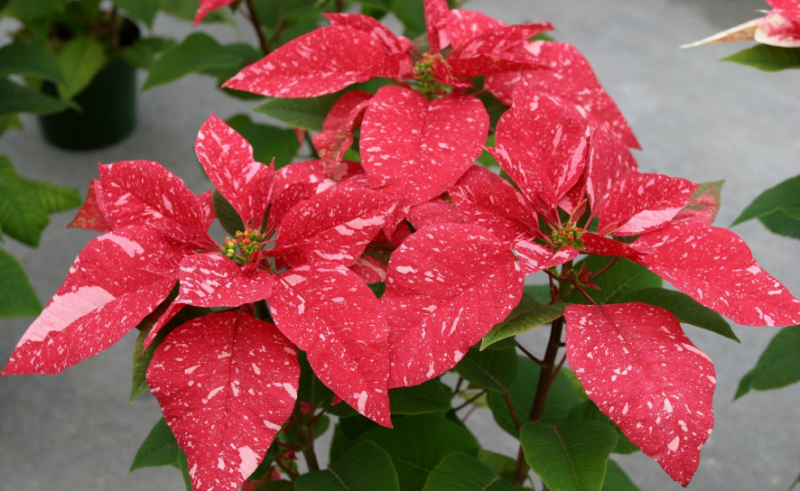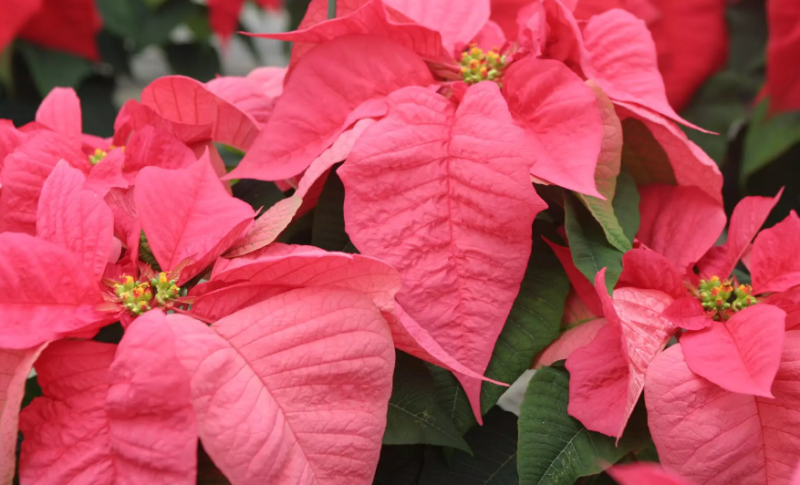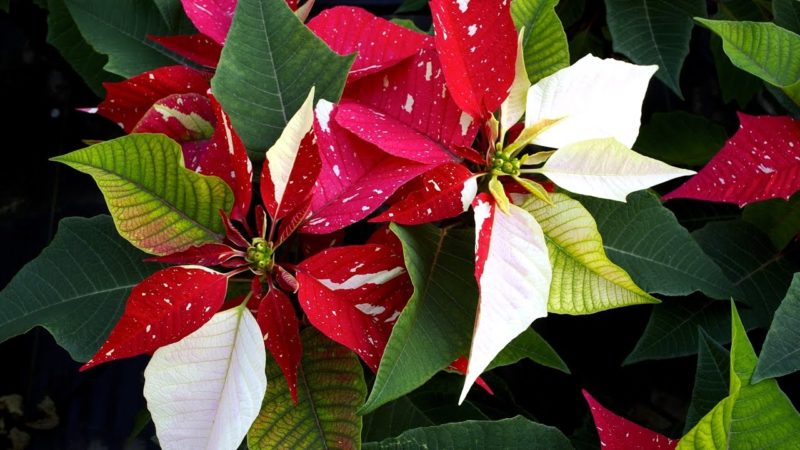Poinsetia, popularly known as euphorbia, is a luxurious flower that pleases its owners with bright bracts in the winter months. The flowers of this plant do not differ in special charm, but the culture does not require special care either. Thanks to the simplicity of home care, poinsetia is very popular among beginner growers.
Material Content:
Varieties for growing at home
To date, breeders have bred several varieties of poinsetia grown at home, which are strikingly different from wild-growing species.
Typically, flower growers prefer the following varieties:
- Oak Leaf. It is the first variety of culture bred for living in an apartment. This variety characterizes the shape of the leaves, similar to that of American oak foliage.
- Premium Red. It is considered a classic with bright red flowers that have a yellow-green, as if luminous, center.
- Cortez Burgundy. It is characterized by a saturation of shades. This culture is distinguished by solemn crimson stipules.
- Cortez Red A particularly attractive variety with a golden hue core surrounded by scarlet leaves with dark green veins.
- Cortez Pink. Differs in special tenderness of shades. This culture has a golden core and pinkish leaves. Moreover, the farther from the top, the lighter the shade;
- Winter Rose. It has a greenish core, which is framed by a luxurious terry rosette.
- Premium Miro.It differs in pressed bent petals of a double color: pink and snow-white.
Due to the efforts of breeders, the poinsettia flower is distinguished by a variety of colors, resistant to diseases and pests.
Tips from experienced gardeners
Experienced gardeners give tips to grow a real "window sill star." Acquiring a culture, it is necessary to inspect the leaves and bracts. They should be without pollen, which is evidence that the plant will soon lose bracts.
First of all, you need to remember that after buying a flower, it should be quarantined for a week. During this time, the punch should get used to the new living conditions. Then the culture should be transplanted into a pot, which should be 2 times less than the length of the plant, and 2 times wider than its root system.
The flowerpot for the flower should not be too large - the soil slowly dries in it. As a result, poinsettia quickly dies in conditions of high humidity.
On a note. It is not recommended to buy poinsettia in the winter months with opened buds.
This culture prefers bright diffused light. Euphorbia feels good in the summer months on balconies that are not exposed to direct sunlight. A plant located in the fresh air must be protected from rain, draft, dry air.
The nuances of caring for a punch
Poinsetia refers to those flowers that can not be bought, put on the windowsill and forget. To get a real beauty, you should carefully look after her, fulfilling some requirements.
Poinset soil
The cultivation of poinsetia should be carried out in the soil with certain characteristics. This culture prefers permeable loose weakly acidic soil. An ideal soil would be a mixture of 3 parts of leaf mixture, 3 parts of turf, 1 part of peat, 1 part of sand. The plant needs drainage, which must lie at the bottom of the pot with a layer of at least 3 cm.
Temperature for growing, flower placement
Poinsetia is a thermophilic crop. She does not tolerate sharp temperature fluctuations, cold, drafts. If in the room where the flower grows, the temperature drops below plus 10 degrees, then the root system rots in it, as a result of which the specimen dies. The most optimal temperature during flowering and growth is considered to be +18 - +25 degrees.
Tip. To prevent burning leaves of milkweed, it is recommended to shade it in the summer months.
How to water
Poinsetia needs frequent watering in the summer months, when flowering occurs and during the active growth of green mass. Daily watering leads to rotting of the root system. It is necessary to carry out it in the case when the drying of the top soil layer has occurred.
Water for irrigation is better to defend. When the plant is at rest, a reduction in moisture is required, but it is forbidden to allow the soil to dry out.
In addition, milkweed requires moist air. Its dryness in the room can lead to the discharge of foliage, lack of flowering. The plant should be systematically sprayed, especially in the winter months, when the room is heated by radiators. In conditions of excessive dryness, the risk of spider mite attack increases.
How and what to feed and fertilize flowers
As soon as the "star of the windowsill" begins active growth, it needs a lot of food, which is provided by timely application of fertilizing. For these purposes, use complex mineral fertilizers. During the growth period, they are made 2 times a month. In the autumn and winter months, milkweed requires an additive rich in potassium and phosphorus, applied once a month.
Transplant and Trim Rules
Milkweed is transplanted in spring, during the period of culture awakening after winter dormancy, when young leaves are formed. The least harm to the plant can be done if the transplant is done by transshipment.For attractive poinsettia, it is recommended to regularly trim it. The first pruning is done after the flowering period ends. The second - after the growth of new shoots.
Tip. During pruning, you can form a punch in the form of a single tree or a bush with several trunks.
During pruning, the plant retains the 5 strongest shoots. The remaining shoots must be carefully cut with a sharpened knife. They can be used for reproduction.
After trimming, the euphorbia should be put in a place that is well lit by sunlight. In this case, the plant should be periodically fed, regularly sprayed, watered. When young shoots reach 10 cm, it is recommended to pinch them.
Poinsetia propagation methods
Poinsetia propagation is carried out in April - May by cuttings. You must choose young ones, whose length is about 6 cm, with several leaves and buds.
- Use a sharp knife to make a neat cut.
- Put the handle in warm water to remove the juice formed during pruning.
- Next should be treated with a drug that stimulates the formation of roots.Tip. The mother tree must be powdered with crushed activated carbon. This will prevent fungal diseases.
- Next, the shoot must be put for rooting in warm water, which must be changed every 4 days.
- During rooting of the plant, the temperature in the room should not be less than plus 24 degrees.
- After the cuttings have given roots (usually this occurs after 30 days), they can be planted in the ground for milkweed.
Important! All manipulations with poinsettia must be carried out with gloves. The plant secretes poisonous juice, which, if ingested, can lead to vomiting, diarrhea, and allergies.
Protection against diseases and pests
Although the “window sill star” is resistant to pests, a culture may still suffer from the following pests:
- Spider mite. This occurs when the euphorbia is in a room with excessive air dryness. You can solve the problem using chemical treatment.
- Whitefly It settles on the bottom of the sheet. In this case, the affected area must be washed under running water, treated with chemicals.
- Mealybug. Covers the leaves of the plant with dew. It is important to timely treat with an alcoholic, soapy solution.
If poinsettia leaves wither, then the plant needs to provide more sunlight. Also, this problem arises due to drafts, lack / excess of water. The leaves of milkweed can also turn yellow against the background of a mite or a sharp change in temperature. Brown spots form on the plant as a result of exposure to sunlight.
Having understood the intricacies of poinsetia care, you can easily grow a beautiful plant on the windowsill, which will delight its owners with an unusual, truly festive flowering.





















